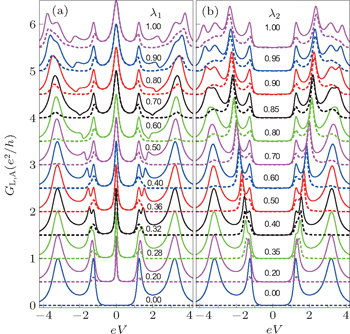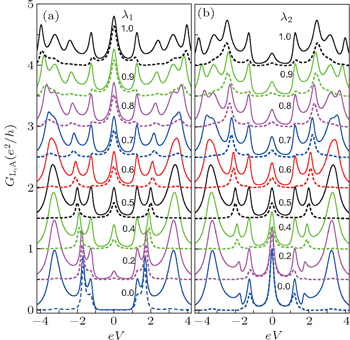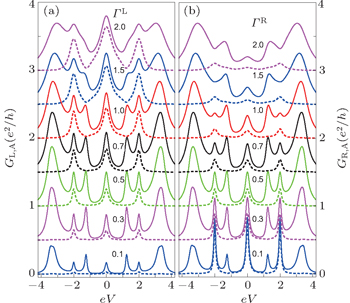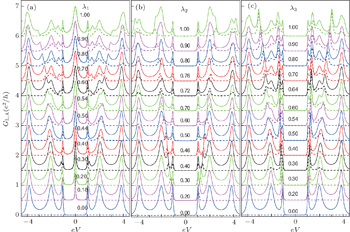† Corresponding author. E-mail:
Project supported by the National Natural Science Foundation of China (Grant Nos. 11274040 and 10974015) and the Program for New Century Excellent Talents in University of China (Grant No. NCET-08-0044).
We investigate the quantum transport properties through a special kind of quantum dot (QD) system composed of a serially coupled multi-QD-pair (multi-QDP) chain and side-coupled Majorana bound states (MBSs) by using the Green functions method, where the conductance can be classified into two kinds: the electron tunneling (ET) conductance and the Andreev reflection (AR) one. First we find that for the nonzero MBS-QDP coupling a sharp AR-induced zero-bias conductance peak with the height of e2/h is present (or absent) when the MBS is coupled to the far left (or the other) QDP. Moreover, the MBS-QDP coupling can suppress the ET conductance and strengthen the AR one, and further split into two sub-peaks each of the total conductance peaks of the isolated multi-QDPs, indicating that the MBS will make obvious influences on the competition between the ET and AR processes. Then we find that the tunneling rate ΓL is able to affect the conductances of leads L and R in different ways, demonstrating that there exists a ΓL-related competition between the AR and ET processes. Finally we consider the effect of the inter-MBS coupling on the conductances of the multi-QDP chains and it is shown that the inter-MBS coupling will split the zero-bias conductance peak with the height of e2/h into two sub-peaks. As the inter-MBS coupling becomes stronger, the two sub-peaks are pushed away from each other and simultaneously become lower, which is opposite to that of the single QDP chain where the two sub-peaks with the height of about e2/2h become higher. Also, the decay of the conductance sub-peaks with the increase of the MBS-QDP coupling becomes slower as the number of the QDPs becomes larger. This research should be an important extension in studying the transport properties in the kind of QD systems coupled with the side MBSs, which is helpful for understanding the nature of the MBSs, as well as the MBS-related QD transport properties.
Majorana fermions (MFs), with their antiparticles being themselves, have attracted lots of attention due to their development in the field of solid state physics in recent years.[1] Their characteristics of non-Abelian statistics make possible their potential application in quantum computation.[2–4] In order to experimentally observe the MFs, plenty of possible systems have been proposed. Among them, the fractional quantum Hall system,[5,6] superconductor,[7,8] and superfluid[9,10] are believed to be the promising ways. Also, the existence of the MFs in a single quantum dot (QD), or in different QDs has been demonstrated in a system consisting of three QDs connected to two conventional superconductors by Deng et al.[11] Moreover, it has been reported that Majorana bound states (MBSs) can be realized at each end of a semiconductor nanowire with strong spin-orbit coupling and Zeeman splitting when the nanowire is placed in proximity to an s-wave superconductor.[12–15]
In spite of the achievements made in searching for the MBSs in solids, the exploration of the methods used to detect the existence of the MBSs is still a vexing question. Several groups have proposed many innovative ideas, such as the noise measurement,[16–19] the resonant Andreev effect,[20,21] and the fractional Josephson effect.[22] Also, QD systems have been suggested as the possible candidates for detecting the MBSs. In 2011 Liu and Baranger found that the conductance through a QD system side-coupled to the end of a p-wave superconducting nanowire shows a sharp jump by a factor of 1/2 as the wire is driven through the topological phase transition, indicating the conductance may be viewed as a probe of the presence of the MBS.[23] Then Cao et al. considered the transport through the QD under the finite bias voltage with particular attention paid to the Majorana's dynamic aspect, and found that a subtraction of the source and drain currents can expose the essential feature of the MFs.[24] In 2013, Lee et al. considered the same setup yet with the QD in the Kondo regime, where they investigated the effect of the MBS on the Kondo physics, showing that the transmission through the QD provides an excellent way to detect the MBS in a much clearer way.[25] Furthermore, the single QD setup side-coupled to the MBSs is generalized to the double QD case. In 2013 Wang et al. used the two QDs connected by an intermediate one-dimensional spin-orbit coupling nanowire to study the entanglement between the two QDs so as to expose the nonlocal quantum nature of the MBSs, which simultaneously provides further evidence for the existence of the MFs.[26] Moreover, Zocher and Rosenow studied the charge transport through a topological superconductor with a pair of MBSs coupled to two leads via two QDs, which shows that the nonlocality of the MBSs opens the possibility of the crossed Andreev reflection (AR).[27] Furthermore, based on the same setup, Liu et al. reported that the two nonlocal processes including the crossed AR and the electron tunneling (ET) can be directly controlled by gating the energy levels of the QDs.[28] Also, Li et al.[29] and Wang et al.[30] performed the detailed investigation on the quantum transport of the double QD system coupled with the MBSs. Shang et al.[31] investigated the electronic transport properties in an Aharonov–Bohm interferometer including two QDs coupled with Majorana fermions. These researches clearly demonstrate that many efforts have been made to detect or expose the nature of the MBSs by utilizing the interplays between the MBSs and the single QD or double.
Recently, the quantum transport through the QDs coupled with the MBSs are further extended to the multi-QD systems. Gong et al. studied the transport properties through a transverse T-shaped linear QD array with the MBS coupled to the terminal QD.[32] It is shown that the existence of the Majorana zero mode completely modifies the electron transport properties of the QD structure. Furthermore, Jiang et al. studied the tunable quantum transport through the horizontal linear QD array with the MBS side-coupled to the QDs, indicating the feasibility to manipulate the current by means of the QD-MBS coupling.[33] These researches are just a starting point of understanding how the MBSs affect the transport properties of the coupled QD systems. A further study on the QD transport properties in the presence of the MBSs is required so as to obtain some universal properties for comprehensively understanding the nature of the MBSs.
Motivated by the aforementioned works, in this paper we propose a serially coupled QDP chain system side-coupled with the MBSs as shown in Fig.
In this paper, using the Green functions method we study the quantum transport properties through the double, triple, and quadruple QDP structures in the presence of the MBSs. First, we consider the conductance through the double QDP structure with the MBS side-coupled to QDP 1, 2, or both, respectively. It is shown that there exists a sharp AR-induced zero-bias conductance peak for the nonzero MBS-QDP coupling when the MBS is coupled to the far left QDP. Moreover, the MBS will make obvious influences on the competition between the ET and AR processes, which results in the splitting of the total conductance peaks of the isolated multi-QDPs. Then we study how the tunneling rate ΓL affects the conductances of leads L and R to deeply understand the transport properties. As a generalization, we then numerically study the influences of the MBS in the triple and quadruple QDPs, which strongly supports the results obtained in the double QDPs. Finally we investigate the conductances of the single, double, triple, and quadruple QDP chains for the different inter-MBS couplings. A detailed comparison shows that the influence of the inter-MBS coupling in the multi-QDP chain is different from that in the single QDP one. These results should be instructive for understanding the influences of the interplay between the regular bound states and the MBSs on the quantum transport in such a kind of QD systems coupled with the MBSs.
The rest of the paper is organized as follows. In Section 2, the model Hamiltonian is presented, and the Green functions as well as the conductance formula are derived. In Section 3, we numerically investigate the conductance through the serially coupled multi-QDP chain. Finally, a brief conclusion is given in Section 4.
The serially coupled QDP chain structure that we considered here is schematically depicted in Fig.








Here λi denotes the coupling between the side QD in the i-th QDP and the nearby MBS. Since there is a bias voltage eV applied between the two leads, we can write the chemical potentials in the left and right leads as μL = εF + eV/2 and μR = εF − eV/2, respectively. Hence, the different chemical potentials will lead to the current transport. In order to obtain the formula of the current following through the leads, the nonequilibrium Green function technique will be used.[34–37] Finally, the current in the αth lead can be expressed as

Here 












In the above equations, we have defined z = ω + i0+. Within the wide-band limit approximation, we will select 
In this section, we will carry out the numerical investigation on the electron transport properties of the QDP chain structures coupled with the MBSs. Here the temperature T is chosen to be zero in the calculation, and the unit of the related parameters is selected to be 10−2 meV as suggested in the previous work.[27] Also, both the QD energy levels εi and 
As a start, we study the quantum transport through the simplest double QDP chain composed of two QDPs in Fig.




Then we consider the quantum transport of the double QDP structure with the MBS coupled to QDP 2 by λ2 in Fig.
Next, in Fig.
Now we turn to study the influences on the conductances GL and GR induced by the coupling ΓL in Figs.
So as to understand the transport properties more completely and deeply, in the following we generalize the discussion from the double QDP system to the triple QDP system. Figures
To provide a more convincing support to the conclusions drawn according to the double and triple QDP systems, we further show some typical conductance curves of the quadruple QDP system in Fig.
Finally, we intend to study the influences of the inter-MBS coupling εM between η1 and η2 on the conductances of the single, double, triple, and quadruple QDP systems in Fig.
In conclusion, we have investigated the quantum transport properties of a serially coupled multi-QDP chain system side-coupled to the MBSs. It is shown that the nonzero MBS-QDP coupling will induce a sharp zero-bias conductance peak when the MBS is coupled to the far left QDP, which is absent when the MBS is coupled to the other QDPs. Besides the zero-bias conductance peak purely caused by the AR process, the MBS-QDP coupling can also induce other pairs of AR conductance peaks near the molecular QD energy levels and make obvious influences on the ET conductance. With the increase of the MBS-QDP coupling, the total conductance is inclined to be split with the ET conductance suppressed and the AR conductance enhanced, showing the competition between the ET and AR processes. Moreover, we study the influences of the tunneling rate ΓL on the conductance of the multi-QDP chain. It is verified that ΓL affects the conductances of leads L and R in different manners, clearly demonstrating that it can effectively adjust the competition between the AR and ET processes. Finally we consider the effect of the inter-MBS coupling on the conductances of the single, double, triple, and quadruple QDP systems. It is found that in the multi-QDP chains the inter-MBS coupling will split the zero-bias conductance peak with the height e2/h into two sub-peaks, which are moved away from each other as the inter-MBS coupling becomes stronger. Contrary to the single QDP structure with the sub-peaks becoming higher, the heights of the two sub-peaks are inclined to become lower. Furthermore, the decay of the conductance peaks with increasing εM becomes slow as the number of the QDPs becomes larger. We believe that this research should be greatly beneficial to understanding the quantum transport in this coupled QDP structure deeply and such a system may be viewed as a more promising candidate used to detect the existence of the MBSs.










